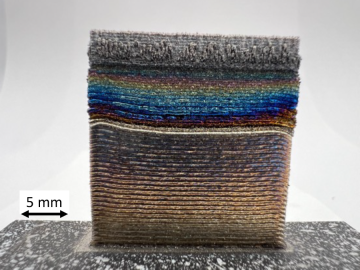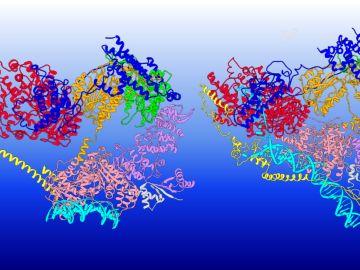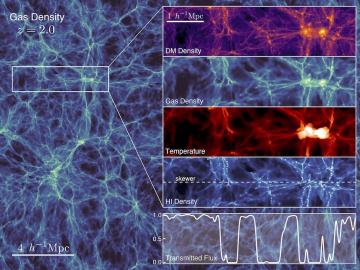
Filter News
Area of Research
- (-) Fusion Energy (17)
- (-) Materials (433)
- (-) Sensors and Controls (5)
- (-) Supercomputing (311)
- Advanced Manufacturing (34)
- Biological Systems (18)
- Biology and Environment (177)
- Biology and Soft Matter (5)
- Building Technologies (12)
- Chemical and Engineering Materials (4)
- Chemistry and Physics at Interfaces (11)
- Clean Energy (522)
- Climate and Environmental Systems (14)
- Computational Biology (6)
- Computational Chemistry (5)
- Computational Engineering (5)
- Computer Science (19)
- Data (1)
- Earth Sciences (1)
- Electricity and Smart Grid (3)
- Energy Frontier Research Centers (14)
- Energy Sciences (5)
- Fossil Energy (3)
- Fuel Cycle Science and Technology (3)
- Functional Materials for Energy (16)
- Fusion and Fission (54)
- Geographic Information Science and Technology (3)
- Isotope Development and Production (3)
- Isotopes (35)
- Materials Characterization (2)
- Materials for Computing (36)
- Materials Synthesis from Atoms to Systems (13)
- Materials Under Extremes (12)
- Mathematics (1)
- National Security (79)
- Neutron Data Analysis and Visualization (4)
- Neutron Science (190)
- Nuclear Science and Technology (74)
- Nuclear Systems Modeling, Simulation and Validation (3)
- Nuclear Systems Technology (1)
- Quantum Condensed Matter (4)
- Quantum information Science (9)
- Reactor Technology (1)
- Renewable Energy (4)
- Transportation Systems (11)
News Type
News Topics
- 3-D Printing/Advanced Manufacturing (26)
- Advanced Reactors (11)
- Artificial Intelligence (38)
- Big Data (19)
- Bioenergy (18)
- Biology (14)
- Biomedical (22)
- Biotechnology (2)
- Buildings (8)
- Chemical Sciences (32)
- Clean Water (3)
- Climate Change (21)
- Composites (9)
- Computer Science (99)
- Coronavirus (17)
- Critical Materials (15)
- Cybersecurity (8)
- Decarbonization (11)
- Energy Storage (37)
- Environment (34)
- Exascale Computing (22)
- Frontier (28)
- Fusion (16)
- Grid (10)
- High-Performance Computing (40)
- Irradiation (1)
- Isotopes (13)
- ITER (1)
- Machine Learning (14)
- Materials (79)
- Materials Science (83)
- Mathematics (1)
- Microscopy (29)
- Molten Salt (3)
- Nanotechnology (42)
- National Security (8)
- Net Zero (2)
- Neutron Science (42)
- Nuclear Energy (27)
- Partnerships (11)
- Physics (34)
- Polymers (18)
- Quantum Computing (20)
- Quantum Science (32)
- Renewable Energy (1)
- Security (7)
- Simulation (14)
- Software (1)
- Space Exploration (5)
- Summit (42)
- Sustainable Energy (19)
- Transformational Challenge Reactor (3)
- Transportation (19)
Media Contacts

Research into a new, unique technology to fabricate composite metal parts for a wide range of applications operating in extreme environments across the aviation, space and energy industries is showing promise for additive manufacturing.

Over the past decade, teams of engineers, chemists and biologists have analyzed the physical and chemical properties of cicada wings, hoping to unlock the secret of their ability to kill microbes on contact. If this function of nature can be replicated by science, it may lead to products with inherently antibacterial surfaces that are more effective than current chemical treatments.

As extreme weather devastates communities worldwide, scientists are using modeling and simulation to understand how climate change impacts the frequency and intensity of these events. Although long-term climate projections and models are important, they are less helpful for short-term prediction of extreme weather that may rapidly displace thousands of people or require emergency aid.

Transcription factor IIH is a veritable workhorse among the protein complexes that regulate human cell activity, playing critical roles both in synthesizing DNA and in enabling DNA repair. But how can one protein assembly participate in two such vastly different jobs? A team of researchers led by chemistry professor Ivaylo Ivanov of Georgia State University used the Summit supercomputer at ORNL to tackle that question.

A research team from the University of California, Santa Cruz, have used the Oak Ridge Leadership Computing Facility’s Summit supercomputer to run one of the most complete cosmological models yet to probe the properties of dark matter.

Researchers at the Department of Energy’s Oak Ridge National Laboratory were the first to use neutron reflectometry to peer inside a working solid-state battery and monitor its electrochemistry.

With the world’s first exascale supercomputer now fully open for scientific business, researchers can thank the early users who helped get the machine up to speed.

Creating energy the way the sun and stars do — through nuclear fusion — is one of the grand challenges facing science and technology. What’s easy for the sun and its billions of relatives turns out to be particularly difficult on Earth.

As a result of largescale 3D supernova simulations conducted on the Oak Ridge Leadership Computing Facility’s Summit supercomputer by researchers from the University of Tennessee and Oak Ridge National Laboratory, astrophysicists now have the most complete picture yet of what gravitational waves from exploding stars look like.

Scientist-inventors from ORNL will present seven new technologies during the Technology Innovation Showcase on Friday, July 14, from 8 a.m.–4 p.m. at the Joint Institute for Computational Sciences on ORNL’s campus.


